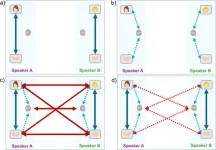(Press-News.org) The five largest continental transform earthquakes since 2000 all originated on a branch of the main fault—and two researchers predict that the next great earthquake of this type will also get its start on a branch or splay fault.
Last year’s magnitude 7.8 Pazarcık earthquake in Türkiye was one of these large and damaging earthquakes, where two continental tectonic plates slide past each other horizontally. That earthquake began on a branch fault, as did the 2001 magnitude 7.8 Kokoxili earthquake in northern Tibet, the 2002 magnitude 7.9 Denali earthquake in Alaska, the 2008 magnitude 7.9 Wenchuan earthquake in China, and the 2016 magnitude 7.8 Kaikōura earthquake in New Zealand.
There are about 25,000 kilometers of continental transform faults across the globe, including some famous ones such as the San Andreas Fault, New Zealand’s Alpine Fault and Türkiye’s North Anatolia Fault. When their time comes to rupture, will they begin on a branch?
In Seismological Research Letters, Ross Stein of Temblor, Inc. and Peter Bird of the University of California, Los Angeles propose that branch faults act as “on-ramps” to generate rupture on the more mature “superhighway” continental transform faults.
At the moment, Stein and Bird’s prediction is a hypothesis that needs more testing, they acknowledge. But magnitude 7.8 or larger earthquakes take place every two to five years on average on these faults, so we shouldn’t have too long to wait to see if their prediction holds up.
“This is testable in about 10 years,” said Stein.
The findings could be useful to adapting earthquake early warning systems and might change which faults are now instrumented and monitored, he added.
The 2023 Türkiye earthquake prompted the researchers to consider the question of where and how great continental transform earthquakes originate.
“It just seemed so bizarre that a magnitude 7.8 earthquake could start on a little wannabe fault … it would be nobody’s candidate for something important,” Stein recalled. “So it raised the question: is this just a freak earthquake or is this telling us something about how earthquakes begin?”
The researchers looked back through the past 25 years of magnitude 7.8 or larger continental transform earthquakes, finding that the five largest nucleated on branch faults. They also identified a few other earthquakes of that magnitude that might have started on a branch fault—including the magnitude 7.8 earthquake that devastated San Francisco in 1906.
Branch faults were not the origin of some slightly smaller earthquakes, however, including the 1990 magnitude 7.7 Luzon earthquake in the Philippines and the 2013 magnitude 7.7 Balochistan earthquake in Pakistan, Stein and Bird concluded.
In their SRL paper, the researchers discuss why large earthquakes might not begin on the main transform fault itself, and how branch faults could initiate a rupture.
The cumulative slip along continental transform faults “smash and shear rocks within a zone about 100 meters wide around the fault,” Stein explained, forming a type of rock called cataclastite. The fractured and chewed-up rock allows rupture at very low shear stress levels, mitigating the buildup of stress that would lead to a large earthquake.
Cataclastite has a lot of pore space between rock grains that could be filled with fluids. If an earthquake were to start on an “on-ramp” branch fault, the researchers propose, the abrupt heat generated by shearing rocks could “suddenly heat up those fluids, which then expand, and it could make the fault suddenly very slippery,” transforming it into a rupture superhighway, Stein said.
“What might make these branch fault ruptures effective in triggering something huge is if they rupture at supershear velocity,” he added.
If the branch fault ruptures at supershear velocity—where the rupture itself is moving faster than the strongest seismic waves—“it could come flying into the main fault at high velocity and kick the main fault hard all at once,” Stein said.
Stein and Bird said all parts of their proposal should be tested going forward, especially since it’s unclear why branch faults might jump-start some continental transform fault earthquakes but not others.
The seismic networks that monitor faults are usually most robust along main faults “because we often think that earthquakes begin on the fault that ultimately slips,” Stein said.
But if Stein and Bird’s hypothesis is correct, “we need to take in a broader area,” he noted. “All these mangy wannabe faults that we pretty much ignore as candidates for big earthquakes actually could be very important.”
END
Are branch faults the “on-ramps” that lead to great continental transform earthquakes?
2024-09-25
ELSE PRESS RELEASES FROM THIS DATE:
Tumour-specific antibodies able to detect melanoma in its earliest stages, new study shows
2024-09-25
(Thursday, 26 September 2024, Amsterdam, Netherlands) Innovative research has unveiled promising advancements in melanoma detection, which could significantly enhance diagnosis and prognosis by identifying the disease at its earliest, most treatable stages.1
This new method, presented today at the European Academy of Dermatology and Venereology (EADV) Congress 2024, uses tumour-specific profiling to detect antibodies unique to stage I and II melanoma patients.
Melanoma, a skin cancer with a high mutation rate,2 ...
When a child hurts, validating their pain may be the best first aid
2024-09-25
Whether it’s a sore arm or a fear of injections, how a child is treated when they present with pain could significantly affect how they respond to and manage pain later in life.
In a new study from the University of South Australia, researchers say that parents and doctors should be mindful of how they talk to and treat children experiencing pain – no matter how big or small the injury – knowing that these foundational experiences can be carried forward into adulthood.
Drawing from diverse research across developmental psychology, child mental health, and pain sciences, researchers say that it may be important to validate children’s pain by ...
Single-dose gene therapy is potentially life-changing for adults with hemophilia B
2024-09-25
PHILADELPHIA – Adults with hemophilia B saw their number of bleeding episodes drop by an average of 71 percent after a single infusion of gene therapy, according to the results of an international Phase III clinical trial published today in the New England Journal of Medicine by researchers from the University of Pennsylvania Perelman School of Medicine and a multicenter group of investigators.
Hemophilia is a genetic disorder that limits the blood’s ability to clot and affects around 30,000 people in the United States, ...
NEJM: Results from targeted therapy for ulcerative colitis study
2024-09-25
An international placebo-controlled study led by Cedars-Sinai suggests that a targeted drug therapy that was developed by researchers at Cedars-Sinai is safe and effective at helping people with moderate to severe ulcerative colitis reach clinical remission.
Results from the multicenter Phase II study, ARTEMIS-UC, were published in The New England Journal of Medicine.
Ulcerative colitis is a type of inflammatory bowel disease (IBD) that damages the digestive tract, causing stomach cramping, diarrhea, weight loss and rectal bleeding. ...
Study finds certain MS therapies may not slow disability progression
2024-09-25
EMBARGOED FOR RELEASE UNTIL 4 P.M. ET, WEDNESDAY, SEPTEMBER 25, 2024
MINNEAPOLIS – In people with primary progressive multiple sclerosis (MS), a new study has found no difference in the amount of time before disability worsened between people taking certain medications and those not receiving treatment. The study is published in the September 25, 2024, online issue of Neurology®, the medical journal of the American Academy of Neurology.
With MS, the body’s immune system attacks myelin, the fatty, white substance that insulates and protects the nerves. People with ...
Are gender and sexual identity linked to brain health?
2024-09-25
EMBARGOED FOR RELEASE UNTIL 4 P.M. ET, WEDNESDAY, SEPTEMBER 25, 2024
MINNEAPOLIS – LGBTQ+ people may be more likely to have negative brain health outcomes, including a higher risk of dementia and late-life depression, than people who are cisgender and straight, according to a study published in the September 25, 2024, online issue of Neurology®, the medical journal of the American Academy of Neurology. These results do not prove that sexual or gender diversity causes neurological diseases, they only show an association.
LGBTQ+ refers to people who are lesbian, gay, bisexual, transgender, ...
The Academy of Science of St. Louis names Katherine Polokonis as executive director
2024-09-25
ST. LOUIS, MO, September 25, 2024 – After an extensive search, The Academy of Science of St. Louis has named Katherine Polokonis as the next Executive Director.
“After a rigorous search, we are looking forward to Kate’s transformational leadership of The Academy of Science,” said Toni Kutchan, PhD, president of the Board of Trustees of the Academy and member emerita, Donald Danforth Plant Science Center. “Kate's comprehensive experience in STEM education and passion for social equity make her ...
How synchronization supports social interactions
2024-09-25
Turn-taking dynamics of social interactions are important for speech and gesture synchronization, enabling conversations to proceed efficiently, according to a study published September 25, 2024, in the open-access journal PLOS ONE by Tifenn Fauviaux from the University of Montpellier, France, and colleagues.
Conversations encompass continuous exchanges of verbal and nonverbal information. Previous research has demonstrated that gestures and speech synchronize at the individual level. But few studies have investigated how this phenomenon ...
Dogs trained to detect explosives may perform worse in extreme temperature and humidity, taking longer to identify substances and with lower sensitivity
2024-09-25
Dogs trained to detect explosives may perform worse in extreme temperature and humidity, taking longer to identify substances and with lower sensitivity
###
Article URL: https://journals.plos.org/plosone/article?id=10.1371/journal.pone.0306817
Article Title: Environmental effects on explosive detection threshold of domestic dogs
Author Countries: USA
Funding: This research was made possible through funding provided by the DoD Army Research Office under Contract No. W911NF2120124. https://www.arl.army.mil/who-we-are/aro/. SAK’s work was supported by the National Science Foundation ...
Digital biomarkers shedding light on seasonality in mood disorders
2024-09-25
Wrist-based activity sensors worn by individuals with depression and those without over the course of two weeks provided evidence for the relationship between daily sunlight exposure and physical activity, according to a study published September 25, 2024, in the open-access journal PLOS Mental Health by Oleg Kovtun and Sandra Rosenthal from Vanderbilt University, U.S.
Mood disorders are the leading cause of ‘disability’ worldwide. Up to 30 percent of individuals with major depressive disorder and bipolar disorder display a seasonal pattern of symptoms. This phenomenon is now recognized in official diagnostic manuals. Yet very little ...

